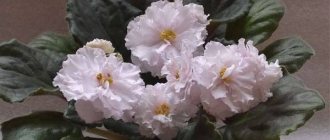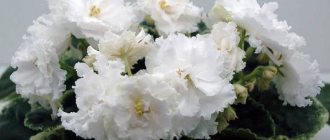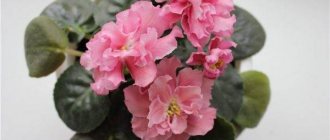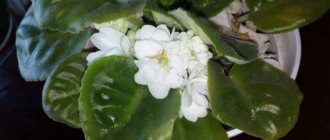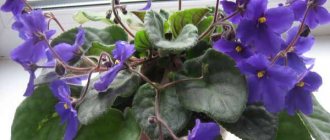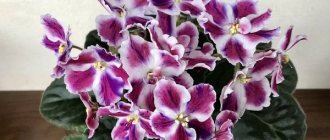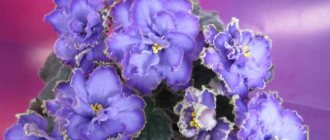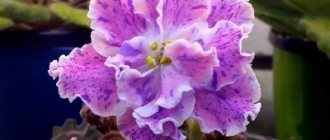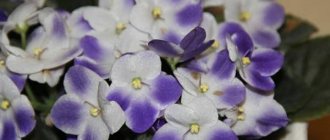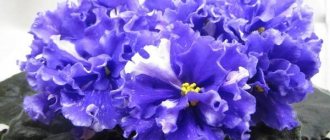Among the huge variety of Uzambara violets, one can distinguish a group of varieties, containing a mention of a particular queen in the title.
Breeders compare violets of this group to royalty
for:
- The rare splendor of their appearance;
- Lush flowering;
- And unusual color tones of the corollas.
The rules for growing “royal” Saintpaulias in indoor culture are not much different from other varieties and hybrids . To preserve their decorative properties and constant flowering, it is enough:
- Maintain comfortable conditions;
- And avoid mistakes in care regimens.
From the group of queen violets, we can recommend the most spectacular varieties , suitable for breeding in the collections of not only experienced, but also novice gardeners. We will talk in more detail about such varieties of violets as Queen of the Elves (Morev), EC Pink Queen, EC Queen of the Ball, EC Queen of Autumn, DEO Queen Elizabeth, EC Queen Margot in the article.
Violet Queen of the Elves
Mysterious violet Queen of the elves.
The variety belongs to the collection developments of Konstantin Lvovich Morev:
- Successful Saintpaulia breeder, known in this field since 1994;
- A student of the famous master of violet breeding B.M. Makuni.
What type of Saintpaulia is it?
Specimens of the Elf Queen can form bushes up to 40 cm in height - the variety belongs to the standard species. Based on the duration of flowering, the plant can be included in the ever-flowering group.
Description
The variety has a fairly compact rosette . The leaves grow in a thick mass of light green color. Leaf blades with wavy edges sit on petioles of a darker tone.
A slight variegation of leaves may unexpectedly appear, which can be passed on to children.
Violet represents varieties with bouquet flowering . Up to 9 buds are formed on each peduncle, opening into double flowers. Medium-sized (about 4 cm) corollas of various shades of pink:
- Edged with a dark stripe;
- And the edges are covered with a thick fringe of pistachio shade.
Peculiarities
The variety does not really like to form a regular contour . Sheet plates:
- They tend to bend in different directions;
- They can hug the pot, which harms the decorative effect of the specimen.
Bushes of different sided configurations .
INTERESTING! The violet is slow in expressing all life cycles. It blooms for a very long time - after one corolla opens, several weeks may pass before the next bud opens. But this feature ensures long-term preservation of violets in a blooming state.
The variety blooms in both hot and cool conditions.
With proper care, it can bloom both in hot and cool conditions for up to 5 months . The duration of flowering depends on:
- Air humidity;
- And regular watering.
Slightly lower temperatures during flowering provoke the formation of very thick fringe on the petals.
Watch the video to see what the Queen of the Elves variety looks like:
RELATED MATERIALS
5
10
All small-fruited citrus fruits are highly ornamental plants and are ideally suited for...
5
What is the secret of the popularity of Saintpaulia and why our grandmothers grew Uzambara for years...
5
One legend says that eucalyptus will help with almost all diseases. But probably …
4,75
3
Is it possible to grow a coffee tree at home? Many people ask this question. We answer: “Yes!” ...
4,6
22
The anthuriums we grow at home come primarily from humid equatorial forests...
5
5
Old gardening books say that fuchsias and pelargoniums are not indoor plants, they are grown...
4,8
1
The variegation of Saintpaulias is due to the absence of green pigment in certain areas of the leaves...
What flower are you based on your date of birth?
Follow our updates! And soon the calendar will be compiled...
Gardeners and flower growers are people too, they love and give new varieties names that are dear to them. And we can...
Violet Pink Queen
Delicate violet Pink Queen.
This plant:
- Represents the excellent work of breeder Elena Vasilyevna Korshunova;
- And the sport of its variety “White Queen” (2006) is of extraordinary beauty.
The sport may appear after the third flowering of the White Queen at elevated temperatures.
What type does it belong to?
The Pink Queen forms rosettes up to 30 cm, belonging to the standard types of Saintpaulia. Instances do not tolerate any of the following:
- Movements;
- And transportation.
can rarely be seen at exhibitions .
Description
The violet rosette has:
- Neat contour;
- And compact sizes.
But with free growth (without proper formation), the plant can bend the leaves down . Shiny leaf plates:
- Painted in dark shades of green;
- And they have small points at the ends.
The underside of the leaf has a reddish tone - this is a characteristic feature of the sport. By this sign it can be recognized before flowering, since the White Queen has completely green leaves.
This variety has regular green leaves.
Sport belongs to the group of violets with cap flowering. The peduncles when forming buds are quite strong, but during flowering:
- They lose strength due to long stalks;
- And turn the corollas heads down.
Large (about 8 cm) flowers are painted in pastel shades of pink and have :
- Terry structure;
- And the wavy edge of each petal.
The degree of terryness of the corollas increases with each subsequent flowering . In some specimens, at the moment of blooming, a yellowish color of the central petals is observed.
Peculiarities
Violet blooms for a long time, but slowly.
IMPORTANT ! The Pink Queen is not picky about care and is suitable for breeding by gardeners with any experience. Its only drawback is poor transportability due to the fact that the petioles become very fragile as the violet matures.
The growth of specimens of this sport is slow. But violet blooms often and for a relatively long time , with a wave amplitude: after 2 months of flowering - a short rest, and flowering again.
It develops best when kept cool.
Diseases and pests
The main causes of illness in the Purple Queen White are management problems. Sudden changes in temperature, excessive humidity, too low or too high temperatures. All this contributes to the appearance of rot, stains or midges.
At the first signs of disease, the viola must be isolated from other plants. The affected parts of the leaves must be removed. Viola must be treated with special means depending on the type of disease. You can find more detailed information about diseases and parasites in a special article on our website.
Don't forget about the flower, take care of it. In this case, the purple-white queen will delight the eye with her snow-white color.
Violet Prom Queen
The variety belongs to the selection collection of E.V. Korshunova (Tolyatti), presented to the attention of flower growers in 2005 .
Violet Prom Queen appeared in 2005.
What type of Saintpaulia is it?
The hybrid variety forms compact rosettes of the standard type - the plant height does not exceed 40 cm.
Description
Violets of this variety are characterized by a large mass of quilted leaves of a rich shade of green with a clear dark pattern along the contour of the veins. Leaf plates have:
- Round shape;
- Weakly expressed wavy edge;
- And a faint silvery coating of lint.
During flowering, the Prom Queen leaves the impression of a very delicate flower due to the fact that the outlines of the corollas strongly resemble apple blossoms.
The variety belongs to the group of violets with a bouquet type of flowering.
Violets produce double, or less often semi-double, flowers of very significant size . The petals have a corrugated structure with faint waves at the edges.
Each petal along the contour is shaded with a bright lilac-purple eyeliner. The color scheme of the flowers themselves varies in shades of the pink palette. The peculiarity of the petals is lilac dot patterns over the entire surface.
Peculiarities
The rosette of violets of this variety likes to form independently , in most cases forming an even outline. A disadvantage with free growth is a slight stretching of the leaves upward.
In terms of growth and bud formation, the Prom Queen can cause some trouble for flower growers .
At the beginning of development from the baby violets look somewhat elongated, modest, with sparse rosettes - as they grow older, these defects disappear.
Violets of this variety can begin to bloom very late , forming modest buds during the first flowering.
ATTENTION! With each subsequent flowering, the volume and charm of the corollas will only increase.
Reviews
Svetlana Vladimirovna. “ I hasten to share my impressions of the exhibition. I saw absolutely unreal beauty there - the White Cradle violet. It’s some kind of magical, airy miracle. I got the impression that in front of me was a bride’s wedding bouquet: many rose-like corollas of sparkling, snow-white color are supported by a frame of dark green leaves, reminiscent of a porta bouquet. I couldn’t resist and bought the baby. Now I will grow such beauty at home.”
Flower growers love the White Cradle for its lush blooms.
Kirill Leopoldovich. “ In my Saintpaulia collection, a whole sector is devoted to varieties with buds of white shades, and the White Cradle violet is generally my favorite. I really like it when the first buds begin to bloom: the flowers from them open up huge, double, snow-white, although the reverse side of the upper petals has a slight greenish coating. Subsequent flowers do not produce such a diameter, but are also very good. In my opinion, this is one of the most spectacular white varieties of violets.”
Violet Queen of Autumn
The original variety was obtained by E.V. Korshunova as a result of painstaking breeding research . Presented to a discerning audience of flower growers in 2009.
Mysterious violet Queen of autumn.
What type is the variety?
Specimens of the Queen of Autumn variety form a medium-sized (no more than 40 cm) rosette - for this reason they are classified as a standard species .
Description
A distinctive feature of the variety is its very pronounced variegation . The violet forms a compact rosette with a smooth outline. The rounded leaf plates are arranged in even tiers.
The lower leaves are painted in dark shades of green with a slight variegation of yellowish color along the wavy edge.
The closer the tier of leaves is to the top of the rosette, the more the leaf plate is painted at the edges in a yellowish-white tone. The end result is a magnificent “autumn meadow”.
The variety belongs to the group of violets with cap flowering, but produces few buds . The corollas bloom large, not double - a simple form of forest violet. The color of the petals changes from the center to the edge from a delicate shade of lilac to a purple edging.
Peculiarities
A variety from the “capricious” category. Characterized by:
- Slow growth;
- Late formation of the first buds;
- And weak formation of a flower cap.
For sufficiently abundant flowering, the amount of nitrogen components in fertilizing should be reduced . In addition, with an overdose of nitrogen, leaf blades can completely lose chlorophyll and turn white.
After the first buds bloom, the variegation of the leaves can intensify ; the same effect is achieved by lower temperatures.
ADVICE! Violet Queen of Autumn loves cool conditions and reacts negatively to excess moisture in the soil - watering specimens of this variety should be done only after the upper part of the substrate has dried.
What flower is this called?
The Chimera owes its name to the ancient Greek mythical creature of the same name.
He was described as a goat with the head of a lion and the tail of a dragon, capable of spitting fire.
Centuries later, chimeras began to be called fictional animals, as well as fiction and fantasies, the existence of which is very difficult to believe.
The uniqueness of Chimera violets lies in the fact that they contain intertwined cells of different varieties. In this case, the cells of the varieties that make up the chimeras do not mix with each other and form layers. The bottom layer sets the color of the petal, the top layer - the stripe that lasts from its base to the tip.
There are the most diverse and bizarre combinations.
It turns out that one violet, like the ancient Chimera, consists of two or more components that belong to other violets . It's really hard to believe, but it's a fact.
Violet DEO-Queen Elizabeth
Varietal specimens were created by a breeder from Moscow Olga Nikolaevna Aksenkina , who in 2006 began to show her selection successes at flower exhibitions in the “New Names” category.
Lush violet Queen Elizabeth.
What type does it belong to?
Plants of varietal violets form very even, neat rosettes , according to the type of which they are included in the group of standard species.
Description
The compact rosette of Saintpaulias of this variety is formed by small, rounded, elongated leaves . Each leaf blade, painted in rich shades of dark green, has a wavy outline.
The variety belongs to violets with a cap type of flowering . Quite a lot of buds are formed, and their terry outlines create a delicate cloud of pink over the green mass. But there are also semi-double specimens.
Violets of this variety have strong, short peduncles bearing up to 5 buds. Violet corollas are large in size (about 6-7 cm). The edges of the petals are decorated with a pronounced fringe.
The color of the flowers is characterized by monotony, only occasionally the central petals of the opening buds may be of a darker shade, which disappears over time.
Peculiarities
ATTENTION! Queen Elizabeth is equally suitable for the collections of experienced flower growers and novice violet lovers. The plant develops easily, without making specific requirements.
These Saintpaulias love to form their rosettes on their own - the result is no worse than when flower growers intervene in this vital process.
The first buds appear quite early , then flowering occurs with enviable frequency and consistency. Each new flowering gives the violet corollas greater splendor and fullness.
History of the species
During the process of violet domestication, an incomplete mutation occurred in the flower cells. Most of the cells received the characteristics of the mother plant, and a smaller part received the characteristics of another species. Since then, chimera violets have appeared in the process of reproduction.
Expert opinion
Pavlova Ekaterina Mikhailovna – agronomist, landscape designer
Participant of scientific conferences
Chimeric mutations still appear spontaneously. For example, the owner of a violet with pink petals, after rooting the cutting, may have a plant with purple stripes in the middle of the petals. Despite the efforts of scientists, it is impossible to obtain such mutations artificially in laboratory conditions. They arise by themselves.
The fact is that tissues of different cellular composition fit tightly to each other, but do not mix.
All that remains is to consolidate the emerging characteristics in a stable combination through selection . However, maintaining a stable color is not an easy and very painstaking task, since the mutation does not appear in every daughter plant.
Violet Queen Margot
Bright violet Queen Margot.
Another selection success of E.V. Korshunova, which was published in 2007 .
What type of Saintpaulia is it?
Forming low, compact rosettes , variegated violets of this variety are classified as a standard species.
Description
Representatives of this variety are distinguished by the original coloring of the leaf plates - the leaves are a very dark shade of green along the contour, surrounded by a border of light beige, the volume of which increases as it approaches the petiole.
The variety produces a small number of buds of large diameter. The flowers are of the semi-double variety.
ATTENTION! The corollas are distinguished by playful colors: from the delicate color of lavender to bright purple interspersed with peach and coral notes.
Peculiarities
The Queen Margot violet, like all variegated leaves, is very sensitive to fertilizing with nitrogen fertilizers - if the percentage of nitrogen is slightly exceeded, it tries to lose its green color. Nitrogen also reduces the number of buds that form.
to keep violets of this variety at standard temperatures , since hot weather contributes to the disappearance of chlorophyll from the leaf blades.
Problems that a florist may encounter
You should always pay close attention to the condition of the plants. It is important to promptly prevent the spread of diseases and pests. Diseases relevant to Saintpaulia ek:
- fungal diseases;
- root rot;
- stem rot;
- leaf rust;
- gray rot;
- late blight;
- powdery mildew;
- vascular bacteriosis.
Additional Information! Due to elevated temperatures, red mites may appear in the flower. When the first “guests” appear, the violets are immediately treated with insecticidal agents.
Typical pests:
- flower thrips;
- cyclamen mite;
- aphid;
- scale insects;
- woodlice;
- sciarids;
- nematodes.
After purchase, it is recommended to replant the plant and inspect the soil. If pests are noticed, the soil is replaced with a better quality one. If the roots have sprouted through the drainage holes, change the flower pot.
Care in indoor culture
Violets require proper care.
To grow healthy specimens of “royal” violets in indoor collections, maintain their magnificent decorative appearance and create comfortable conditions during flowering, you should carefully follow simple care rules.
Conditions of detention
The optimal conditions for violets would be to place them on the windowsills of the western or eastern side of the house.
There is a balance between:
- The amount of light;
- Its brightness;
- And the direction of the rays.
On south-facing windows, plants require shading on hot summer days , and when placed on northern windowsills, additional lighting with daylight spectrum lamps should be provided.
IMPORTANT! Regardless of placement, violets of “royal” varieties need protection from drafts and sudden temperature fluctuations.
Watering and fertilizing mode
Regular watering for “royal” violets , based on visual monitoring of the condition of the substrate:
- Watering through a tray would be ideal - this method will protect the plant from soil acidification;
- The wick method of watering is also used.
With any method, you should avoid getting water on:
- Leaf plates;
- Or flowers.
Violets need to be watered once a week.
Arranging a drainage layer in the flowerpot will prevent rotting of the roots from excess water.
The feeding procedure can be carried out once a month if clearly necessary . When fertilizing at different periods of the life cycle of violets, it is necessary to regulate the percentage of content in the fertilizer:
- Nitrogen;
- Phosphorus;
- And potassium.
Lighting and temperature conditions
Violets of “royal” varieties need long-term illumination with a diffuse spectrum without direct sunlight. This will protect plants from:
- Sunburn;
- And overheating.
Maintaining temperature conditions plays a significant role in the life processes of violets. This may depend on:
- Rosette growth rate;
- Quantity and quality of formed buds;
- The degree of manifestation of variegation and much more.
Violets for the most part react positively to maintaining the temperature at +20 + 24°C. Minor fluctuations in indicators during the day are allowed.
IMPORTANT! For variegated varieties, it is recommended to reduce the temperature by 2 - 3 degrees.
Effect of air humidity
Violets grown indoors require an increased level of air humidity . To create the necessary indicators you need to use:
- Humidifiers;
- Or ordinary vessels with water.
Saintpaulias love moist air.
You should not place flowerpots with violets in close proximity to central heating radiators - they dry out the air greatly . If necessary, you can spray the air around the plant.
But too high humidity is dangerous for violets - it promotes the active development of rot pathogens.
Soil requirements
To maintain good health and decorative value of the violet, it must have healthy and strong roots. And this depends on the quality of the substrate. Soil for violets is taken:
- Nutritious;
- Light;
- Water permeable;
- And with sufficient aeration.
According to acidity readings, a slightly acidic earthen mixture is suitable .
ADVICE! Drainage materials and charcoal can be added to the soil for violets.
Pruning and hygiene
The procedure for pruning violet bushes is carried out for the purpose of:
- Formation of a harmonious contour;
- Maintaining a decorative appearance;
- And hygienic cleaning.
It is necessary to remove old leaves from Saintpaulias.
This removes:
- Old, damaged leaves;
- Dried flower corollas;
- Bare peduncles;
- And if necessary, unclaimed shoots and extra leaf plates.
After pruning, the violet receives more nutrition and light, and the risk of plant rotting due to damaged areas is reduced.
Rules for transplantation and rejuvenation
When preparing violets for transplantation, it is necessary to focus on several aspects:
- Choose a plastic flowerpot slightly larger than the previous one, but three times smaller than the diameter of the rosette;
- Place drainage material at the bottom of the pot;
- Prepare a substrate - ready-made from the store is safer in terms of disease infection and already contains everything necessary for violets;
- Lightly moisten the soil in the flowerpot first.
Next, you should choose between transshipment and transfer:
- Transshipment does the least harm to the roots;
- And replanting makes it possible to check the health of the root system and completely replace the soil.
, rejuvenation can be carried out for it :
- Separation of the upper part of the bush with strong, young leaves;
- Cleaning the stem to a height of 3 cm;
- And rooting the prepared plant in water or soil.
Old violets need to be rejuvenated.
Rejuvenation is carried out for:
- Life extension;
- Improvements in decorative appearance;
- And preserving the varietal properties of Saintpaulia.
How to choose?
Before you get a white beauty, you need to choose the right violet variety. It is best to buy plants in specialized stores, since “counterfeits” (off-grade flowers) are often found on the market. When purchasing violets, it is important to pay attention to the following indicators.
External view of the socket. A rosette that is too tight indicates the presence of a disease in the flower.
It should also be noted that by purchasing one cutting of a plant, in the future you can get several full-fledged indoor flowers.
Growing conditions
The violet variety “Sea Wolf” is completely undemanding to environmental conditions. It tolerates dry air, but does not tolerate drying out of the earthen clod at all. With insufficient watering, the leaves lose their original appearance and become as if lifeless.
Priming
You can make a substrate for growing violets at home yourself or purchase a high-quality soil mixture in a specialized store. The main requirement is looseness and moisture permeability. If the soil is too dense, the violet will not be able to feel comfortable in it.
This variety can be grown on a wick irrigation system. In this case, it is optimal to plant the plant in sterile peat with the addition of perlite. Such soil is most suitable for this technique.
Paying attention to the initial nutritional value of the substrate is completely optional. Due to frequent watering, nutrients are rapidly washed out of the soil, so houseplants need proper organization of fertilizing.
https://forumimage.ru/uploads/20170801/150161327353521847
Pot
It is necessary to plant a young violet (starter) in a small pot, a diameter of 6-7 cm is sufficient. As the plant grows, it is transplanted into large containers - up to 10 cm. If you plan to not allow the rosette to grow to large dimensions, the volume of the substrate is reduced.
At the bottom of the pot, be sure to arrange drainage, in a layer of up to 3 cm. It is better to lay expanded clay of a large fraction on the bottom, and on top of it - a fine one. This way the moisture will drain away better.
Lighting
For normal growth and flowering, violets need high-quality lighting. The duration of daylight should be at least 12 hours during the period of active growth and from 10 hours during the period of rest. The indoor flower feels great on windowsills of eastern and western orientation. On southern windows it needs shading during the midday hours, and on northern windows it may refuse to bloom due to lack of lighting.
If it is not possible to provide the flower with light under natural conditions, you should resort to artificial lamps. They are placed directly above the plant at a distance of at least 20-30 cm, otherwise the flower may get burned.
Temperature
This is one of the most important criteria ensuring the growth and development of culture. The air temperature in the room where the violet grows should be about 20 degrees. Increasing the indicator above 26 and below 16 degrees is destructive, the flower may die.
Air humidity
For the “Sea Wolf” variety, air humidity is not the most significant indicator, but it will feel more comfortable at an indicator of 50%. In summer and spring, such levels are natural for residential premises, and in case of a slight decrease, they are easily compensated for by spraying.
Many plants die in winter due to the operation of heating devices: hot centralized heating and radiators. This problem should be anticipated in advance, and you should buy an air humidifier that works automatically or by using improvised means. You can improve the indicator slightly by placing the plants on a tray with moistened expanded clay, or by curtaining the radiators with a damp cloth.
https://cstor.nn2.ru/userfiles/data/ufiles/2018-10/76/af/f7/5bd04e61adec4_orskoy_volk
Chateau Brion
Peduncles erect, powerful. The flowers look like pompoms, large, double, and wine-colored. The edge of the petals is decorated with a wide corrugated white border. The socket is standard. The leaves are slightly wavy, elongated-ovate in shape.
Variegated
There are 3 types of variegation. The most beautiful is the type with bordering variegated leaves. In such plants, light areas are located evenly along the contour of the foliage.
The color of variegated leaves can be white, cream, white-pink, brown, grayish-pink, less often yellow, dark pink. The intensity of the variegated color depends on the conditions of the plant and the air temperature. In a cool and well-lit room, the flower becomes more vibrant. With a lack of light, the leaves become greener, and in some cases the variegation disappears entirely (during flowering). Coloring is inherited rather poorly.
With crown variegation, the center of the rosettes is colored golden, pink and white. This species is the most stable and is inherited.
Rows of green foliage alternate with colored ones. During the flowering period, in most varieties the center of the rosettes turns green.
A more stable type is mosaic variegation. The foliage of such violets is partially or completely covered with an irregular, intricate pattern, similar to a pattern on marble or a mosaic of cream, pink, streaks and spots. This type of violet is quite rare.
Another type is known, this is spontaneous variegation. These plants do not transmit variegation from the parent varieties.
Summer twilight
The flower has the correct proportions. Flowering is quite abundant. The inflorescences are large, semi-double, contrasting. The background color of the petals is lilac-violet. The edges are trimmed with white ruffle. The leaves are variegated, slightly concave. The edges are slightly wavy. The rosette is smooth, spherical in shape.
Blue Dragon
The flowers are large, pale blue. The edge of the petal has a white-green border. The socket is powerful and flat. The leaves are dark green in color, with a crimson or purple tint on the underside. The variety is grown on a well-lit windowsill or loggia.
South night
The variety has dark blue simple star-shaped flowers with bright crimson fantasy peas and a thin white border. The foliage is dark green with pink splashes. The socket is smooth, standard sizes.
Chic poppy
This is a variegated plant with double, large-sized flowers with a wavy, fringed edge. The flowers reach 6 centimeters in diameter. The edges of the petals are dimpled, similar to ruffles. The coloring of the petals is excellent, from light pink to orange-red tones. The leaves are pubescent, spade-shaped, decorative. Light greens from the center become discolored and turn into white tones, making them variegated. At times the leaves become completely white.
